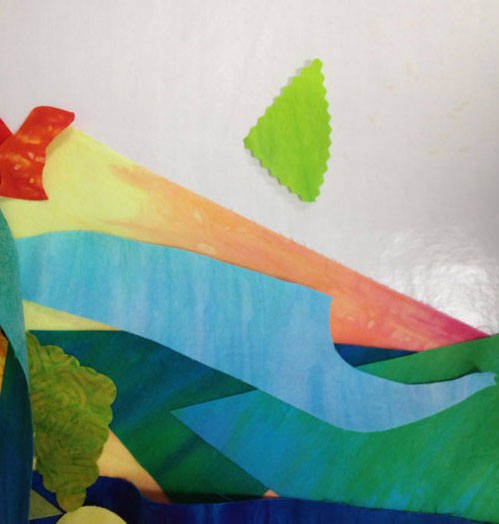 My third method of creating original art quilts begins with a Design Trigger. This way of designing artwork is all about improvisation. There’s no pattern, no theme, no idea. Like walking a tight rope in the dark, you never know what you’ll encounter. Thrilling stuff for a textile artist who lives a safe and cozy life like me!
My third method of creating original art quilts begins with a Design Trigger. This way of designing artwork is all about improvisation. There’s no pattern, no theme, no idea. Like walking a tight rope in the dark, you never know what you’ll encounter. Thrilling stuff for a textile artist who lives a safe and cozy life like me!
Design Triggers
My design triggers are pre-fused fabric scraps. I keep all the cut-aways or fused fabric scraps from previous projects. The fusible web or glue on these fabrics never goes bad and those odd little shapes provide just the right impetus to launch a new design. (You can learn more about fusing here.)
Think of fused fabric scraps as the starter dough for your next art quilt. There is so much potential in these little bits of fabric. But there are pros and cons when selecting the Design Trigger method.
Pros: You are allowed to improvise. There is no pattern needed, no preconceived design you have to try to emulate. You are free to make it up as you go along.
Cons: There is no pattern or sketch on which to base your design. You have to fearlessly cut into your precious fabric and hope it turns out like you want it. Once it’s cut, you can’t go back.
Here are some tips when creating with Design Triggers
- Be brave! Take a chance and cut into the fabric.They are manufacturing fabric at a furious rate.You won’t run out.
- Make design elements as a unit (like the house above) so you can try placing them in different places on background fabric.
- Build your design on a Teflon sheet, silicone release paper, or parchment paper. This gives you the option of changing the size and shape of the design before applying it to batting.
- If you don’t like how the design is turning out, set it aside and start another design. Art making takes practice and fusing lets you make lots of art work.
- For a successful quilt, follow the rules from the Chicago School of Fusing.
I hope you’ve enjoyed these three methods of designing art quilts. Now get out there and make something!



